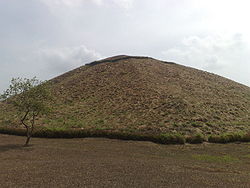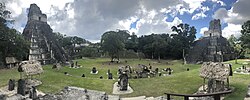Mesoamerican chronology
Looking at the history of pre-Columbian Mesoamerica one can see some rather different periods between the first humans and the early Colonial period (which followed the Spanish colonization of the Americas) in the end.
Overview
Paleo-Indian period
The Paleo-Indian (not so often Lithic) period or era begins with the first signs of human presence in the region and leads to agriculture and other practices (e.g. pottery, permanent settlements) characteristic of proto-civilizations. In Mesoamerica, the end of this phase was about 8,000 BC. It was a period of hunter-gatherers.
Archaic Era
c. 8,000 BCE - 2,000 BCE
In this time agriculture and permanent villages developed in the region. Late in this era, people used pottery and started weaving with a loom.
Preclassic Era or Formative Period
c. 2,000 BCE - 200 CE
Nation-states developed and with them the first large scale ceremonial architecture and cities. That were the Olmec civilization, the early Zapotec, Monte Alto Culture in Guatemala's Pacifc lowlands, and Maya civilization.
Classic Era
c. mid 2nd century - early 10th century
Teotihuacan grows to a metropolis and its empire dominates Mesoamerica. During this time the cities of the Maya southern lowlands, such as Tikal, Palenque, and Copán have their greatest era. The Classic Era ended earlier in Central Mexico, with the fall of Teotihuacan around the 7th century, than it did in the Maya area, which continued for centuries more. Around this time, many southern lowland sites (most notably in Tikal) experienced a short period of limited decline, called the Middle Classic Hiatus. The later period of Maya's continued growth is sometimes known as the Florescent Era.
Postclassic Era
10th century - 16th century.
Many of the great nations and cities of the Classic Era collapsed, but some continue, such as in Oaxaca, Cholula, and the Maya of Yucatán, such as at Chichen Itza and Uxmal. This is sometimes seen as a period of increased chaos and warfare. The Toltec dominated central Mexico in the 11th - 13th century, then collapsed. The northern Maya are for a time united under Mayapan. The Aztec Empire rises in the early 15th century and seems on the path to gain a dominance over the whole region not seen since Teotihuacan, when Mesoamerica is discovered by Spain and conquered by the Conquistadores. Arguably, the Post-Classic continued until the conquest of the last independent native state of Mesoamerica, Tayasal, in 1697.
Mesoamerican Chronology Media
Recreation of Temple Rosalila at the Museum of Maya Sculpture, Honduras
Recreation of Tenochtitlan by Diego Rivera.
Archaeological zone of Tlatelolco, the Church on the ruins exemplifies the process of change from the post-classic period to the colonial period.
Several of the most prominent Formative Period sites in the central Mexican plateau and Gulf Coast regions.
Bibliography
- Carmack, Robert; et al. (1996). The legacy of Mesoamerica: history and culture of a Native American civilization. New Jersey: Prentice Hall. ISBN 0-13-337445-9.
- Coe, Michael D. (1996). Mexico: from the Olmecs to the Aztecs. New York: Thames and Hudson. ISBN 0-500-27722-2.
- Fernández, Tomás; Jorge Belarmino (2003). La escultura prehispánica de mesoamérica. Barcelona: Lunwerg Editores. ISBN 84-9785-012-2.
- de la Fuente, Beatrice (2001). De Mesoamérica a la Nueva España. Oviedo, Spain: Consejo de Comunidades Asturianas. ISBN 84-505-9611-4.
- Gamio, Manuel (1922). La Población del Valle de Teotihuacán: Representativa de las que Habitan las Regiones Rurales del Distrito Federal y de los Estados de Hidalgo, Puebla, México y Tlaxcala (2 vols. in 3 ed.). Mexico City: Talleres Gráficos de la Secretaría de Educación Pública.
- Kirchhoff, Paul (1943). "Mesoamérica. Sus Límites Geográficos, Composición Étnica y Caracteres Culturales". Acta Americana. 1 (1): 92–107.
- Kuehne Heyder, Nicola; Joaquín Muñoz Mendoza (2001). Mesoamérica: acercamiento a una historia. Granda, Spain.: Diputación Provincial de Granada. ISBN 84-7807-008-7.
- López Asutin, Alfredo; Leonardo López Luján (1996). El pasado indígena. Mexico: El Colegio de México. ISBN 968-16-4890-0.
- Palerm, Ángel (1972). Agricultura y civilización en Mesoamérica. Mexico: Secretaría de Educación Pública. ISBN 968-13-0994-4.
- de Sahagún, Bernardino (1982) [1950]. Florentine Codex: General History of the Things of New Spain. Arthur J. O. Anderson and Charles E. Dibble (eds.) (13 vols. in 12 ed.). Santa Fe: School of American Research. ISBN 0-87480-082-X.
- Wauchope, Robert, ed. (1964–76). Handbook of Middle American Indians (16 vols. ed.). Austin: University of Texas Press. ISBN 9780292700147.
- Weaver, Muriel Porter (1993). The Aztecs, Maya, and Their Predecessors: Archaeology of Mesoamerica (3rd ed.). San Diego: Academic Press. ISBN 0-01-263999-0.
- West, Robert C.; John P. Augelli (1989). Middle America: Its Lands and Peoples (3rd ed.). Englewood Cliffs, N.J.: Prentice Hall. ISBN 0-13-582271-8.
- Wolf, Eric Robert (1967). Pueblos y culturas de Mesoamérica. Bilioteca Era.
- Duverger, Christian (1999): Mesoamérica, arte y antropología. CONACULTA-Landucci Editores. Paris. ISBN 970-18-3751-7.
- Miller, Mary Ellen. (2001). El arte de mesoamérica. "Colecciones El mundo del arte". Ediciones Destino. Barcelona, España. ISBN 84-233-3095-8.
- Several Authors. (1996) "Historia General de Guatemala" ISBN 84-88622-06-6.









